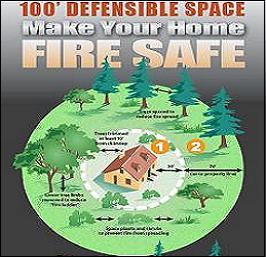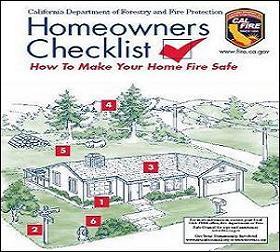Prevention and Preparedness
Creating Defensible Space is the key to protecting your home from potential wildfire threats.
(Cal Fire: used with permission)
Whether or not you have 30-100 feet (ft.) of space from your home structure to the end of your property, everyone can follow the basic principles of Defensible Space and create a safe zone around your home by considering the following:
Labor: Yard work upkeep can go a long way in preventing a fire from destroying your home.
- Move combustible items (wood stacks, engines, oil/gas, etc) as far from the home as possible.
- Remove and keep combustible items from below decks, and keep vegetation from growing underneath them as well.
- Remove leaves, needles, and branches that are touching or are on the roof, rain gutters, or the chimney.
- Trim tree branches up from the ground 6-9 ft. or roughly 3 times the height of closest shrub. (ex: 4 ft. shrub means 12 ft. of clearance from the ground up on the closest tree.)
- Plants trees and shrubs 8-10 ft. from the home and 8-10 ft. from each other. The distance is increased if your home is on a sloping or steep hill - about 20 ft. for medium sloped hill and 30 ft. for a steep one.
- Remove all dead or dying plants, leaves, cones, needles, twigs, and branches from the ground within 30 ft. of the home.
Plants, Materials and Construction: Make smart decisions and long-term investments when building, remodeling, and landscaping your home. Firewise has a detailed checklist of items to consider.
- Look for potential problem areas in and around your home and perform a fire hazard assessment.
- Plant native trees, shrubs and bushes. Shorter is better than taller. Grass and flowers are better than trees and shrubs. Trees that shed their leaves and slow growing plants with high water content are ideal. Other attributes include low total, dead vegetation and open loose branches. However, more important than plant characteristics is where the plant is located on the property - its proximity to other plants and the home structure.
- Use fire resistant materials for the home such as stucco, stoner or brick siding, dual-panned windows with steel framing, and a tile, concrete or metal roofing.
- Enclose eaves and overhangs to keep heat from being trapped in along the exterior siding of the home.
- Cover vents with thin metal wiring to prevent embers and flames from getting inside.
- Clean chimney and protect with them with spark arrestor caps.
Preparedness: In addition to Defensible Space there are other safety and administrative measures necessary to be completed before a fire threatens your home.
- Get your homeowners insurance coverage up-to-date if you have made any additions to your home.
- Take and occasionally update an inventory of your possessions using a Home Inventory Guide. Other online home inventory sites are available as well. As a disclaimer, we neither discourage nor endorse the use of these sites.
- Make sure your home address is visible from the street.
- Make sure your street sign is named or numbered and visible.
- Identify different emergency routes out of the home and 2 exit routes from your neighborhood. Have your Family Emergency Plan and Emergency Kits ready.
- Cleary mark all emergency water sources: pool, pond, well or fire hydrant.
A more detailed list, on how to prevent fires from both inside and outside the home, can be found in this checklist.
(Cal Fire: used with permission)







